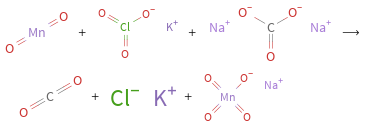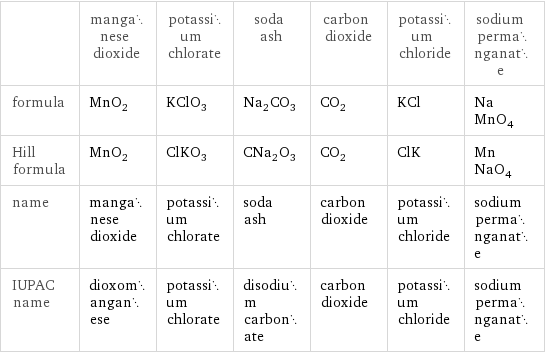Input interpretation

MnO_2 manganese dioxide + KClO_3 potassium chlorate + Na_2CO_3 soda ash ⟶ CO_2 carbon dioxide + KCl potassium chloride + NaMnO_4 sodium permanganate
Balanced equation

Balance the chemical equation algebraically: MnO_2 + KClO_3 + Na_2CO_3 ⟶ CO_2 + KCl + NaMnO_4 Add stoichiometric coefficients, c_i, to the reactants and products: c_1 MnO_2 + c_2 KClO_3 + c_3 Na_2CO_3 ⟶ c_4 CO_2 + c_5 KCl + c_6 NaMnO_4 Set the number of atoms in the reactants equal to the number of atoms in the products for Mn, O, Cl, K, C and Na: Mn: | c_1 = c_6 O: | 2 c_1 + 3 c_2 + 3 c_3 = 2 c_4 + 4 c_6 Cl: | c_2 = c_5 K: | c_2 = c_5 C: | c_3 = c_4 Na: | 2 c_3 = c_6 Since the coefficients are relative quantities and underdetermined, choose a coefficient to set arbitrarily. To keep the coefficients small, the arbitrary value is ordinarily one. For instance, set c_2 = 1 and solve the system of equations for the remaining coefficients: c_1 = 2 c_2 = 1 c_3 = 1 c_4 = 1 c_5 = 1 c_6 = 2 Substitute the coefficients into the chemical reaction to obtain the balanced equation: Answer: | | 2 MnO_2 + KClO_3 + Na_2CO_3 ⟶ CO_2 + KCl + 2 NaMnO_4
Structures

+ + ⟶ + +
Names

manganese dioxide + potassium chlorate + soda ash ⟶ carbon dioxide + potassium chloride + sodium permanganate
Equilibrium constant
![Construct the equilibrium constant, K, expression for: MnO_2 + KClO_3 + Na_2CO_3 ⟶ CO_2 + KCl + NaMnO_4 Plan: • Balance the chemical equation. • Determine the stoichiometric numbers. • Assemble the activity expression for each chemical species. • Use the activity expressions to build the equilibrium constant expression. Write the balanced chemical equation: 2 MnO_2 + KClO_3 + Na_2CO_3 ⟶ CO_2 + KCl + 2 NaMnO_4 Assign stoichiometric numbers, ν_i, using the stoichiometric coefficients, c_i, from the balanced chemical equation in the following manner: ν_i = -c_i for reactants and ν_i = c_i for products: chemical species | c_i | ν_i MnO_2 | 2 | -2 KClO_3 | 1 | -1 Na_2CO_3 | 1 | -1 CO_2 | 1 | 1 KCl | 1 | 1 NaMnO_4 | 2 | 2 Assemble the activity expressions accounting for the state of matter and ν_i: chemical species | c_i | ν_i | activity expression MnO_2 | 2 | -2 | ([MnO2])^(-2) KClO_3 | 1 | -1 | ([KClO3])^(-1) Na_2CO_3 | 1 | -1 | ([Na2CO3])^(-1) CO_2 | 1 | 1 | [CO2] KCl | 1 | 1 | [KCl] NaMnO_4 | 2 | 2 | ([NaMnO4])^2 The equilibrium constant symbol in the concentration basis is: K_c Mulitply the activity expressions to arrive at the K_c expression: Answer: | | K_c = ([MnO2])^(-2) ([KClO3])^(-1) ([Na2CO3])^(-1) [CO2] [KCl] ([NaMnO4])^2 = ([CO2] [KCl] ([NaMnO4])^2)/(([MnO2])^2 [KClO3] [Na2CO3])](../image_source/051b94a0d4fc458d4b8060602134b140.png)
Construct the equilibrium constant, K, expression for: MnO_2 + KClO_3 + Na_2CO_3 ⟶ CO_2 + KCl + NaMnO_4 Plan: • Balance the chemical equation. • Determine the stoichiometric numbers. • Assemble the activity expression for each chemical species. • Use the activity expressions to build the equilibrium constant expression. Write the balanced chemical equation: 2 MnO_2 + KClO_3 + Na_2CO_3 ⟶ CO_2 + KCl + 2 NaMnO_4 Assign stoichiometric numbers, ν_i, using the stoichiometric coefficients, c_i, from the balanced chemical equation in the following manner: ν_i = -c_i for reactants and ν_i = c_i for products: chemical species | c_i | ν_i MnO_2 | 2 | -2 KClO_3 | 1 | -1 Na_2CO_3 | 1 | -1 CO_2 | 1 | 1 KCl | 1 | 1 NaMnO_4 | 2 | 2 Assemble the activity expressions accounting for the state of matter and ν_i: chemical species | c_i | ν_i | activity expression MnO_2 | 2 | -2 | ([MnO2])^(-2) KClO_3 | 1 | -1 | ([KClO3])^(-1) Na_2CO_3 | 1 | -1 | ([Na2CO3])^(-1) CO_2 | 1 | 1 | [CO2] KCl | 1 | 1 | [KCl] NaMnO_4 | 2 | 2 | ([NaMnO4])^2 The equilibrium constant symbol in the concentration basis is: K_c Mulitply the activity expressions to arrive at the K_c expression: Answer: | | K_c = ([MnO2])^(-2) ([KClO3])^(-1) ([Na2CO3])^(-1) [CO2] [KCl] ([NaMnO4])^2 = ([CO2] [KCl] ([NaMnO4])^2)/(([MnO2])^2 [KClO3] [Na2CO3])
Rate of reaction
![Construct the rate of reaction expression for: MnO_2 + KClO_3 + Na_2CO_3 ⟶ CO_2 + KCl + NaMnO_4 Plan: • Balance the chemical equation. • Determine the stoichiometric numbers. • Assemble the rate term for each chemical species. • Write the rate of reaction expression. Write the balanced chemical equation: 2 MnO_2 + KClO_3 + Na_2CO_3 ⟶ CO_2 + KCl + 2 NaMnO_4 Assign stoichiometric numbers, ν_i, using the stoichiometric coefficients, c_i, from the balanced chemical equation in the following manner: ν_i = -c_i for reactants and ν_i = c_i for products: chemical species | c_i | ν_i MnO_2 | 2 | -2 KClO_3 | 1 | -1 Na_2CO_3 | 1 | -1 CO_2 | 1 | 1 KCl | 1 | 1 NaMnO_4 | 2 | 2 The rate term for each chemical species, B_i, is 1/ν_i(Δ[B_i])/(Δt) where [B_i] is the amount concentration and t is time: chemical species | c_i | ν_i | rate term MnO_2 | 2 | -2 | -1/2 (Δ[MnO2])/(Δt) KClO_3 | 1 | -1 | -(Δ[KClO3])/(Δt) Na_2CO_3 | 1 | -1 | -(Δ[Na2CO3])/(Δt) CO_2 | 1 | 1 | (Δ[CO2])/(Δt) KCl | 1 | 1 | (Δ[KCl])/(Δt) NaMnO_4 | 2 | 2 | 1/2 (Δ[NaMnO4])/(Δt) (for infinitesimal rate of change, replace Δ with d) Set the rate terms equal to each other to arrive at the rate expression: Answer: | | rate = -1/2 (Δ[MnO2])/(Δt) = -(Δ[KClO3])/(Δt) = -(Δ[Na2CO3])/(Δt) = (Δ[CO2])/(Δt) = (Δ[KCl])/(Δt) = 1/2 (Δ[NaMnO4])/(Δt) (assuming constant volume and no accumulation of intermediates or side products)](../image_source/d9551573f1117914c48b8d8de27c2e99.png)
Construct the rate of reaction expression for: MnO_2 + KClO_3 + Na_2CO_3 ⟶ CO_2 + KCl + NaMnO_4 Plan: • Balance the chemical equation. • Determine the stoichiometric numbers. • Assemble the rate term for each chemical species. • Write the rate of reaction expression. Write the balanced chemical equation: 2 MnO_2 + KClO_3 + Na_2CO_3 ⟶ CO_2 + KCl + 2 NaMnO_4 Assign stoichiometric numbers, ν_i, using the stoichiometric coefficients, c_i, from the balanced chemical equation in the following manner: ν_i = -c_i for reactants and ν_i = c_i for products: chemical species | c_i | ν_i MnO_2 | 2 | -2 KClO_3 | 1 | -1 Na_2CO_3 | 1 | -1 CO_2 | 1 | 1 KCl | 1 | 1 NaMnO_4 | 2 | 2 The rate term for each chemical species, B_i, is 1/ν_i(Δ[B_i])/(Δt) where [B_i] is the amount concentration and t is time: chemical species | c_i | ν_i | rate term MnO_2 | 2 | -2 | -1/2 (Δ[MnO2])/(Δt) KClO_3 | 1 | -1 | -(Δ[KClO3])/(Δt) Na_2CO_3 | 1 | -1 | -(Δ[Na2CO3])/(Δt) CO_2 | 1 | 1 | (Δ[CO2])/(Δt) KCl | 1 | 1 | (Δ[KCl])/(Δt) NaMnO_4 | 2 | 2 | 1/2 (Δ[NaMnO4])/(Δt) (for infinitesimal rate of change, replace Δ with d) Set the rate terms equal to each other to arrive at the rate expression: Answer: | | rate = -1/2 (Δ[MnO2])/(Δt) = -(Δ[KClO3])/(Δt) = -(Δ[Na2CO3])/(Δt) = (Δ[CO2])/(Δt) = (Δ[KCl])/(Δt) = 1/2 (Δ[NaMnO4])/(Δt) (assuming constant volume and no accumulation of intermediates or side products)
Chemical names and formulas

| manganese dioxide | potassium chlorate | soda ash | carbon dioxide | potassium chloride | sodium permanganate formula | MnO_2 | KClO_3 | Na_2CO_3 | CO_2 | KCl | NaMnO_4 Hill formula | MnO_2 | ClKO_3 | CNa_2O_3 | CO_2 | ClK | MnNaO_4 name | manganese dioxide | potassium chlorate | soda ash | carbon dioxide | potassium chloride | sodium permanganate IUPAC name | dioxomanganese | potassium chlorate | disodium carbonate | carbon dioxide | potassium chloride | sodium permanganate
Substance properties

| manganese dioxide | potassium chlorate | soda ash | carbon dioxide | potassium chloride | sodium permanganate molar mass | 8.6936×10^1 g/mol | 1.225×10^2 g/mol | 1.0599×10^2 g/mol | 4.4009×10^1 g/mol | 7.455×10^1 g/mol | 1.4192×10^2 g/mol phase | solid (at STP) | solid (at STP) | solid (at STP) | gas (at STP) | solid (at STP) | liquid (at STP) melting point | 5.35×10^2 °C | 3.56×10^2 °C | 8.51×10^2 °C | -5.656×10^1 °C (at triple point) | 7.7×10^2 °C | boiling point | | | 1.6×10^3 °C | -7.85×10^1 °C (at sublimation point) | 1.42×10^3 °C | 1×10^2 °C density | 5.03×10^0 g/cm^3 | 2.34×10^0 g/cm^3 | | 1.84212×10^-3 g/cm^3 (at 2×10^1 °C) | 1.98×10^0 g/cm^3 | 1.391×10^0 g/cm^3 solubility in water | insoluble | soluble | soluble | | soluble | dynamic viscosity | | | 3.55×10^-3 Pa s (at 9×10^2 °C) | 1.491×10^-5 Pa s (at 2.5×10^1 °C) | | odor | | | | odorless | odorless |
Units
